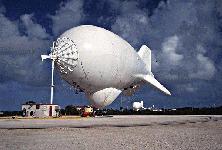
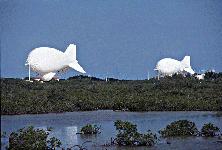
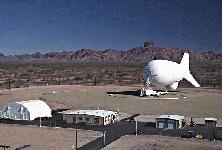
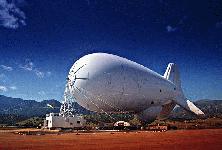
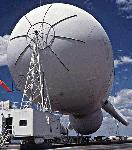
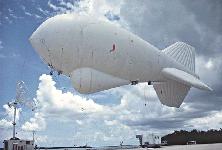
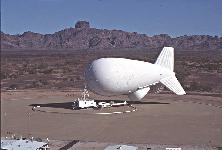
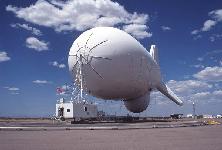
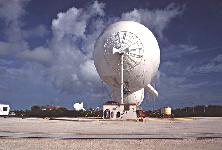
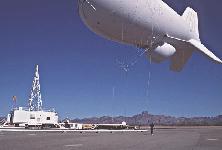
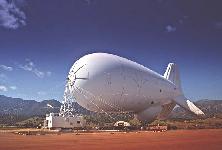
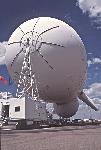
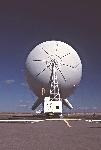
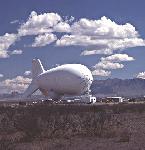
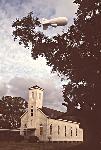
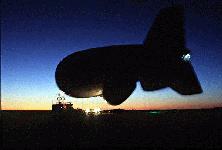
2004-05-12 米軍、イラクにロッキードの気球偵察システムを配備
米軍はロッキード・マーチンとの間で56000立方フィート(1586立方メートル)の気球利用偵察システムの配備契約を1.6Mドルで調印した。気球には多種多様なセンサーが取り付けられ、バグダッド周辺の地上軍の防衛や装備の護衛に利用する。気球は地上とケーブルでつながれている。ロッキード・マーチンはテザー気球レーダシステム(TARS)のシステムインテグレータ及び運用サービス企業でもある。TARSの使用と画像を以下に示す。(出典:FAS)
U.S. ARMY TO DEPLOY LOCKHEED MARTIN AEROSTAT SURVEILLANCE SYSTEMS IN IRAQ
The U.S. Army awarded Lockheed Martin a $1.6 million contract to provide the first of two 56,000-cubic-foot tethered aerostat surveillance systems for deployment in Iraq. The aerostats, equipped with various sensors, will provide a persistent surveillance capability in the defense of ground forces and high-value assets in Baghdad.
Lockheed Martin will integrate existing aerostats with their sensors, ground
stations and mooring systems at its facility in Akron. Lawrence Livermore
National Laboratory, Livermore, CA, will evaluate the equipment during
integration. The Army's Program Executive Office for Intelligence, Electronic
Warfare and Sensors and PM RUS (Program Manager for Robotic Unmanned Sensors)
at Fort Monmouth, NJ, will provide program and acquisition management.
The Army will receive the first system in June 2004 and the second system
within two months of the first system."This integrated capability
evidences our aggressive responsiveness to a time-critical need for persistent
surveillance to support and enable our Army's mission and task at war,"
said Edward Bair, the Army's program executive officer for Intelligence,
Electronic Warfare and Sensors. "Only through the combined efforts
of a focused Army-Lockheed Martin-PM RUS team will we achieve that goal."
"Aerostat surveillance systems give the Army the additional intelligence
collection capability vital to protecting ground forces and high-value
assets," said Ron Browning, business development director at Lockheed
Martin Maritime Systems & Sensors. "Our team is committed to completing
the assembly and integration of the equipment to deploy the two systems
as quickly as possible."
Aerostats and other lighter-than-air systems provide low-cost, long-endurance
surveillance capabilities not possible with other types of aircraft. Attached
by a high-strength cable to a mooring system, aerostats may carry different
types of surveillance equipment to conduct multiple missions. They are
filled with helium and stay airborne around-the-clock. Lockheed Martin
Maritime Systems & Sensors has delivered more than 8,000 aerostats
for military and commercial uses.
Lockheed Martin is the systems integrator, and operations and maintenance
provider for the Tethered Aerostat Radar System (TARS) operated by the
U.S. Air Force along the southern U.S. border. TARS uses Lockheed Martin's
larger 420K (420,000 cubic feet) tethered aerostats and L-88 radar in support
of air sovereignty and counter-drug operations conducted by North American
Aerospace Defense Command, U.S. Coast Guard and U.S. Customs Air and Marine
Interdiction Coordination Center.
主要仕様
Primary Function Low-level radar aircraft detection
Prime Contractor ILC Dover and TCOM, LP (aerostat manufacturers and maintenance)
Lockheed Martin Corp. (radar operations and maintenance)
Lockheed Martin System Services & Training Services (operations and maintenance)
Volume 275,000-625,000 cubic feet
Tether Length 25,000 feet
Payload Weight 1,200-3,400 pounds
Maximum Detection Range 200 Miles
Date Deployed 1978
Inventory 12 +spares
Operational Sites Yuma and Ft Huachuca, Ariz.;
Deming N.M.;
Marfa, Texas;
Eagle Pass, Texas;
Matagorda, Texas;
Rio Grande, Texas;
Morgan City, La.;
Cudjoe Key (2 aerostats operate at Cudjoe Key)
Horseshoe Beach, Fla.;
Lajas, Puerto Rico.
The Georgetown and Great Inagua sites have been deactivated, and are no longer in existance -- only the flight pad remains.
The aerostat at Deming is also out of service due to a dust devil passing over the site which caused the aerostat to open and deflate.















